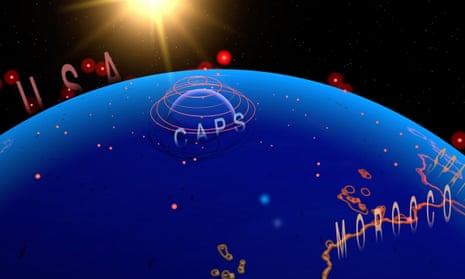Five months ago, a pretty important envelope dropped into the mailbox of Meriem Bennani’s lawyer. The Moroccan-born, New York-based artist had been granted a green card, and was now a lawful, permanent resident of the US. “It’s weird,” she says over a glass of sparkling water in a bar close to Nottingham Contemporary, the gallery where she is installing Life on the Caps, her new video exhibition. “Of course, I’m grateful. My whole life has been lived from visa to visa.” She expresses ambivalence towards her new home, before adding that she doesn’t want to focus too much on herself, “because, you know, I’m OK”.
This puts Bennani in dramatic contrast to the characters in Party on the Caps and Life on the Caps, her two half-hour videos set in a futuristic sci-fi detention camp called Caps (short for “capsule”), situated on an island in the middle of the Atlantic. In the films, teleportation has replaced air travel. Would-be illegal immigrants to the US are intercepted as they attempt to zap across the Atlantic, and interned in the camp, which has developed from an insular holding pen to a sprawling migrant settlement and Latin quarter.
We’re introduced to the camp by Fiona, an animated crocodile, cereal box character and unofficial camp mascot (Bennani has a master’s degree in animation from the École Nationale Supérieure des Arts Décoratifs in Paris, as well as a bachelor’s in fine art from the Cooper Union in New York). Then we meet the human inhabitants of the Moroccan neighbourhoods, who party, protest, play music, undergo strange age-reversal procedures, create memes, flip off the American “troopers” who oversee the island, and sometimes address the camera directly, in this strange mix of pseudo-documentary and sci-fi cartoon.

Bennani loved Disney movies as a child growing up in Rabat, the Moroccan capital, and was particularly taken with the ones that mixed live action with animation, such as the 1964 musical Mary Poppins. “That blew me away!” she says. “I was like, ‘How do they do that?’”
The artist is familiar with postcolonial politics, understanding now how two staples of her childhood – Disney videos and the Cartoon Network channel – may have served veiled, neocolonial ends. She regards Fantasia, the 1940 Mickey Mouse movie, as Disney’s biggest imperialistic “flex”. She says: “It’s the pure awesomeness of animation, plus the addition of European classical music. It’s like ‘empire!’ but it’s still beautiful and magical.” A third Caps film, not showing in Nottingham, pays tribute to Fantasia, while twisting the story to address the multitudes who lie beyond America’s borders.
Moroccan rappers and social media stars perform alongside Bennani’s friends and family in her Caps films, each acting the part of an islander. This addition of north African pop, as well as computer-generated animation, means the films stay pacy, and never shade into boring polemics.

It all sounds like an odd mix for a film-maker, but for Bennani it’s a pretty well-established formula. In Fly, an animated fruit fly guides viewers around the private lives of citizens in Rabat and Fez. In Mission Teens, Bennani appeared as a CGI donkey, shooting footage of real-life, snotty teens at elite, French-speaking schools in Rabat. And in 2 Lizards, Bennani and her flatmate – fellow animator Orian Barki – cast themselves as languid talking reptiles, trying to make the best of life in lockdown Manhattan.
This work, which the animators posted on Instagram, became a pandemic hit, and led to more commercial inquiries. “We developed a TV show, but it didn’t work out,” Bennani explains. “It was too mainstream for the art world, but too weird for Hollywood.”
She and Barki are working on a new script, but while that’s in development she’s happy to be opening her show at a free-to-visit gallery in the centre of a significant British city, which draws in visitors from many walks of life. “That’s really important to me,” Bennani says. “I’m quite bored by the art audience, the art world,” she says. “That’s not who I make the work for.”
Nottingham is, of course, the setting for one of Disney’s better-known films, Robin Hood. “It wasn’t one I watched a lot,” she says. “But ethically, it’s not bad.”). And British politics is providing Bennani’s show with a fitting backdrop, the government having recently announced its plans to send asylum-seekers to Rwanda. The artist sighs as I mention this. Science fiction, for her, isn’t about craftily predicting the future, but more about finding ways to think about our lives today. The Home Office’s overseas processing plans place her imaginary island in perspective. “It is,” she says, with a brisk, almost cartoonish sense of despair, “barely a dystopia.”
Meriem Bennani: Life on the Caps is at Nottingham Contemporary until 4 September.
